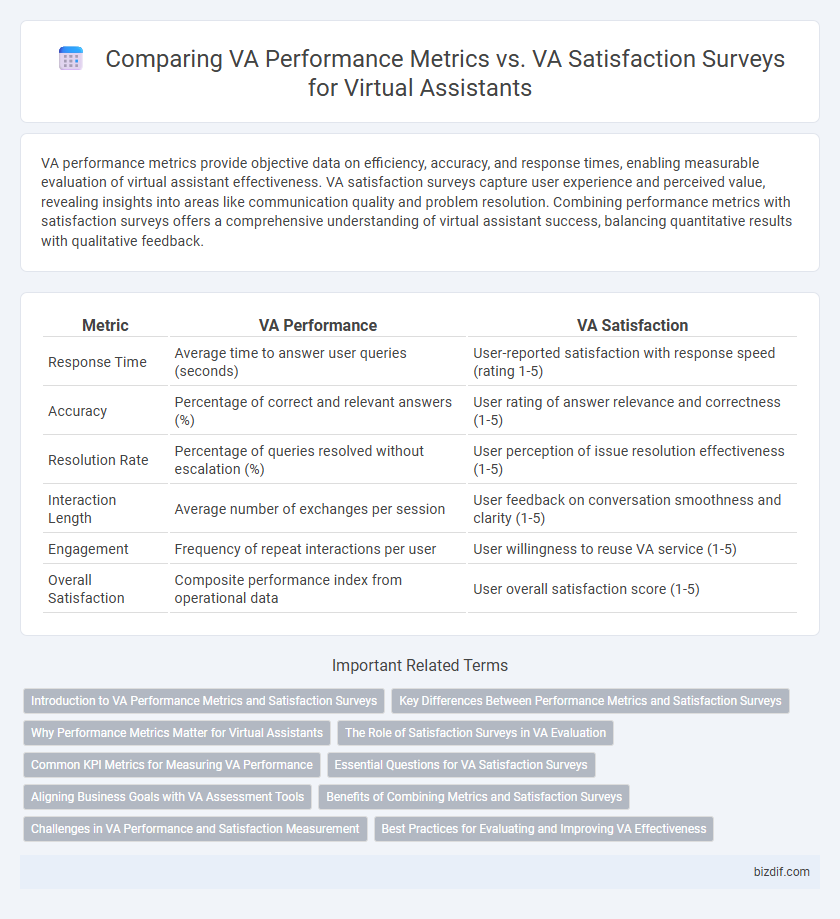VA performance metrics provide objective data on efficiency, accuracy, and response times, enabling measurable evaluation of virtual assistant effectiveness. VA satisfaction surveys capture user experience and perceived value, revealing insights into areas like communication quality and problem resolution. Combining performance metrics with satisfaction surveys offers a comprehensive understanding of virtual assistant success, balancing quantitative results with qualitative feedback.
Table of Comparison
| Metric | VA Performance | VA Satisfaction |
|---|---|---|
| Response Time | Average time to answer user queries (seconds) | User-reported satisfaction with response speed (rating 1-5) |
| Accuracy | Percentage of correct and relevant answers (%) | User rating of answer relevance and correctness (1-5) |
| Resolution Rate | Percentage of queries resolved without escalation (%) | User perception of issue resolution effectiveness (1-5) |
| Interaction Length | Average number of exchanges per session | User feedback on conversation smoothness and clarity (1-5) |
| Engagement | Frequency of repeat interactions per user | User willingness to reuse VA service (1-5) |
| Overall Satisfaction | Composite performance index from operational data | User overall satisfaction score (1-5) |
Introduction to VA Performance Metrics and Satisfaction Surveys
VA performance metrics quantify task completion rates, response accuracy, and average handling times to objectively assess virtual assistant efficiency. VA satisfaction surveys capture user feedback on ease of interaction, problem resolution, and overall experience, providing qualitative insights into user satisfaction. Combining performance metrics with satisfaction surveys enables a comprehensive evaluation of virtual assistant effectiveness and user-centric improvements.
Key Differences Between Performance Metrics and Satisfaction Surveys
Virtual assistant performance metrics measure objective data such as response accuracy, task completion rate, and average handling time, providing quantifiable insights into operational efficiency. In contrast, VA satisfaction surveys capture subjective user feedback on experience aspects like ease of use, perceived helpfulness, and overall satisfaction. These key differences highlight performance metrics as technical indicators, while satisfaction surveys reflect user-centric perceptions essential for comprehensive VA effectiveness evaluation.
Why Performance Metrics Matter for Virtual Assistants
Performance metrics provide quantifiable data on virtual assistant efficiency, response accuracy, and task completion rates, enabling targeted improvements in service delivery. Unlike satisfaction surveys, which capture subjective user feedback prone to bias, performance metrics offer objective, actionable insights essential for optimizing virtual assistant algorithms and workflows. Prioritizing these metrics ensures consistent quality, faster resolution times, and measurable enhancements in user experience.
The Role of Satisfaction Surveys in VA Evaluation
Satisfaction surveys play a crucial role in virtual assistant evaluation by capturing user perceptions and emotional responses that performance metrics alone cannot measure. These surveys provide qualitative insights into user experience, helping identify areas for improvement in communication, responsiveness, and overall interaction quality. Combining satisfaction survey data with quantitative performance metrics enables a comprehensive assessment of virtual assistant effectiveness and user alignment.
Common KPI Metrics for Measuring VA Performance
Common KPI metrics for measuring virtual assistant performance include response time, task completion rate, accuracy, and customer interaction volume. These quantitative indicators provide objective data to evaluate efficiency, effectiveness, and reliability in handling user requests. VA satisfaction surveys complement these metrics by capturing qualitative feedback on user experience, engagement, and perceived helpfulness, essential for holistic performance assessment.
Essential Questions for VA Satisfaction Surveys
VA performance metrics like response time, accuracy, and task completion rate provide quantitative data crucial for evaluating efficiency. VA satisfaction surveys focus on qualitative insights, emphasizing essential questions about user experience, such as the assistant's ease of use, communication clarity, and problem resolution effectiveness. Prioritizing these satisfaction factors helps refine virtual assistant interactions beyond metric-driven performance, ensuring user-centric improvements.
Aligning Business Goals with VA Assessment Tools
Evaluating virtual assistant (VA) performance through quantitative metrics such as task completion rate and response time provides objective data essential for measuring operational efficiency. VA satisfaction surveys capture qualitative insights from users, highlighting areas impacting user experience and engagement. Aligning these assessment tools with business goals ensures a balanced approach to optimize both productivity and customer satisfaction.
Benefits of Combining Metrics and Satisfaction Surveys
Combining VA performance metrics with VA satisfaction surveys provides a comprehensive understanding of virtual assistant effectiveness by measuring both operational efficiency and user experience. Performance metrics analyze response accuracy, speed, and resolution rates, while satisfaction surveys capture qualitative feedback on user satisfaction and engagement. Integrating these data sources enables continuous improvement, aligning VA capabilities with user expectations and driving higher overall service quality.
Challenges in VA Performance and Satisfaction Measurement
Measuring virtual assistant (VA) performance through metrics such as response accuracy, task completion rate, and average handling time often fails to capture the nuanced user experience reflected in VA satisfaction surveys. Challenges arise due to the subjective nature of satisfaction surveys, which can be influenced by user expectations, emotional responses, and situational context, making it difficult to correlate directly with objective performance data. This disconnect hampers the ability to accurately evaluate VA effectiveness and improve both functionality and user satisfaction comprehensively.
Best Practices for Evaluating and Improving VA Effectiveness
Tracking virtual assistant performance metrics such as response accuracy, resolution time, and user engagement rates provides quantifiable data to measure efficiency and identify technical issues. Incorporating VA satisfaction surveys captures user sentiment and identifies pain points that metrics alone may overlook, offering qualitative insights into the user experience. Combining these methods with ongoing analysis ensures a comprehensive evaluation, enabling targeted improvements that enhance both functionality and user satisfaction.
VA performance metrics vs VA satisfaction surveys Infographic

 bizdif.com
bizdif.com